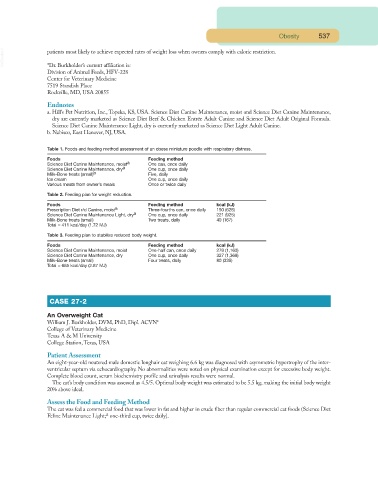Page 521 - Small Animal Clinical Nutrition 5th Edition
P. 521
Obesity 537
VetBooks.ir patients most likely to achieve expected rates of weight loss when owners comply with caloric restriction.
*Dr. Burkholder’s current affiliation is:
Division of Animal Feeds, HFV-228
Center for Veterinary Medicine
7519 Standish Place
Rockville, MD, USA 20855
Endnotes
a. Hill’s Pet Nutrition, Inc., Topeka, KS, USA. Science Diet Canine Maintenance, moist and Science Diet Canine Maintenance,
dry are currently marketed as Science Diet Beef & Chicken Entrée Adult Canine and Science Diet Adult Original Formula.
Science Diet Canine Maintenance Light, dry is currently marketed as Science Diet Light Adult Canine.
b. Nabisco, East Hanover, NJ, USA.
Table 1. Foods and feeding method assessment of an obese miniature poodle with respiratory distress.
Foods Feeding method
Science Diet Canine Maintenance, moist a One can, once daily
Science Diet Canine Maintenance, dry a One cup, once daily
Milk-Bone treats (small) b Five, daily
Ice cream One cup, once daily
Various meats from owner’s meals Once or twice daily
Table 2. Feeding plan for weight reduction.
Foods Feeding method kcal (kJ)
Prescription Diet r/d Canine, moist a Three-fourths can, once daily 150 (628)
Science Diet Canine Maintenance Light, dry a One cup, once daily 221 (925)
Milk-Bone treats (small) Two treats, daily 40 (167)
Total = 411 kcal/day (1.72 MJ)
Table 3. Feeding plan to stabilize reduced body weight.
Foods Feeding method kcal (kJ)
Science Diet Canine Maintenance, moist One-half can, once daily 278 (1,163)
Science Diet Canine Maintenance, dry One cup, once daily 327 (1,368)
Milk-Bone treats (small) Four treats, daily 80 (335)
Total = 685 kcal/day (2.87 MJ)
CASE 27-2
An Overweight Cat
William J. Burkholder, DVM, PhD, Dipl. ACVN*
College of Veterinary Medicine
Texas A & M University
College Station, Texas, USA
Patient Assessment
An eight-year-old neutered male domestic longhair cat weighing 6.6 kg was diagnosed with asymmetric hypertrophy of the inter-
ventricular septum via echocardiography. No abnormalities were noted on physical examination except for excessive body weight.
Complete blood count, serum biochemistry profile and urinalysis results were normal.
The cat’s body condition was assessed as 4.5/5. Optimal body weight was estimated to be 5.5 kg, making the initial body weight
20% above ideal.
Assess the Food and Feeding Method
The cat was fed a commercial food that was lower in fat and higher in crude fiber than regular commercial cat foods (Science Diet
a
Feline Maintenance Light; one-third cup, twice daily).

